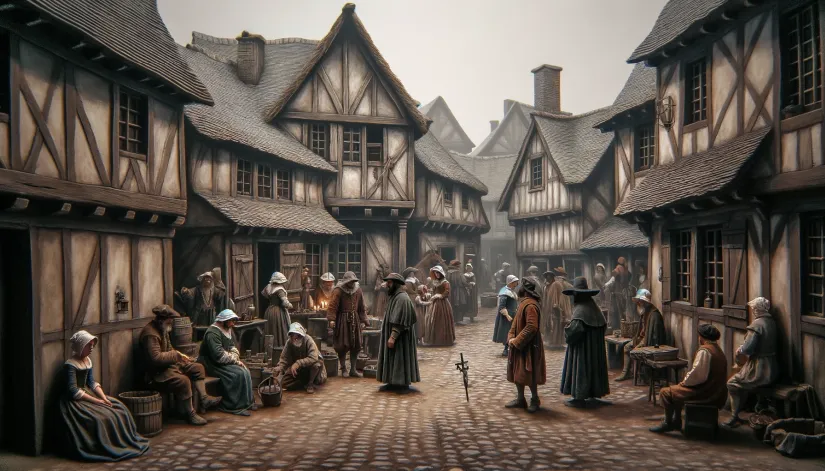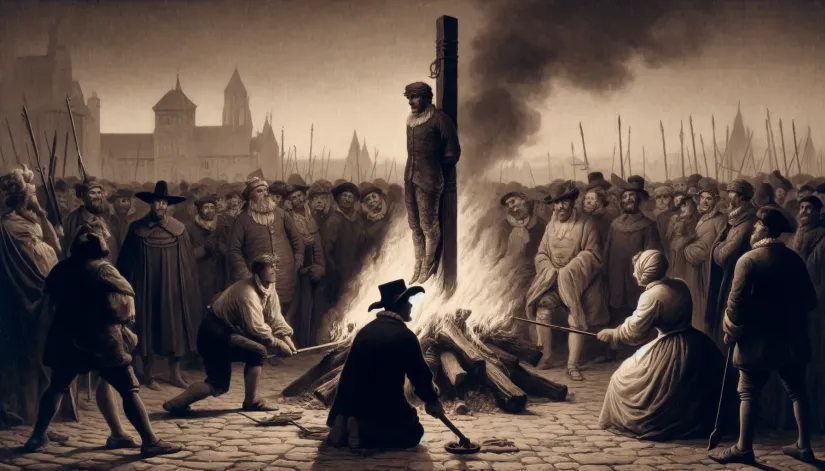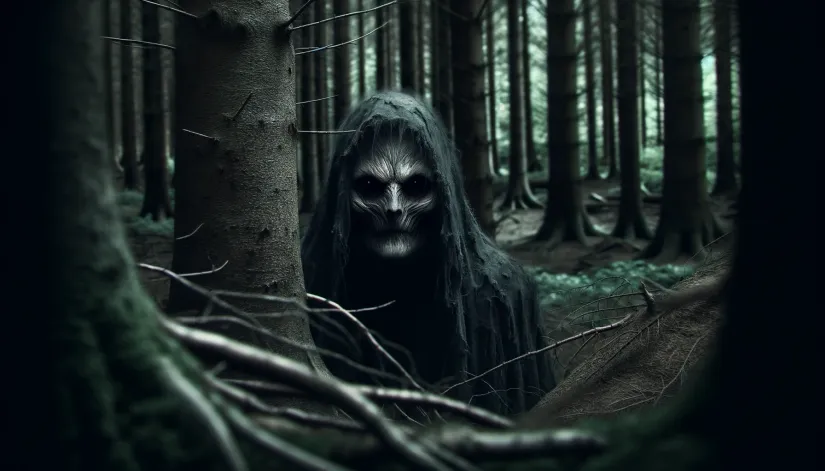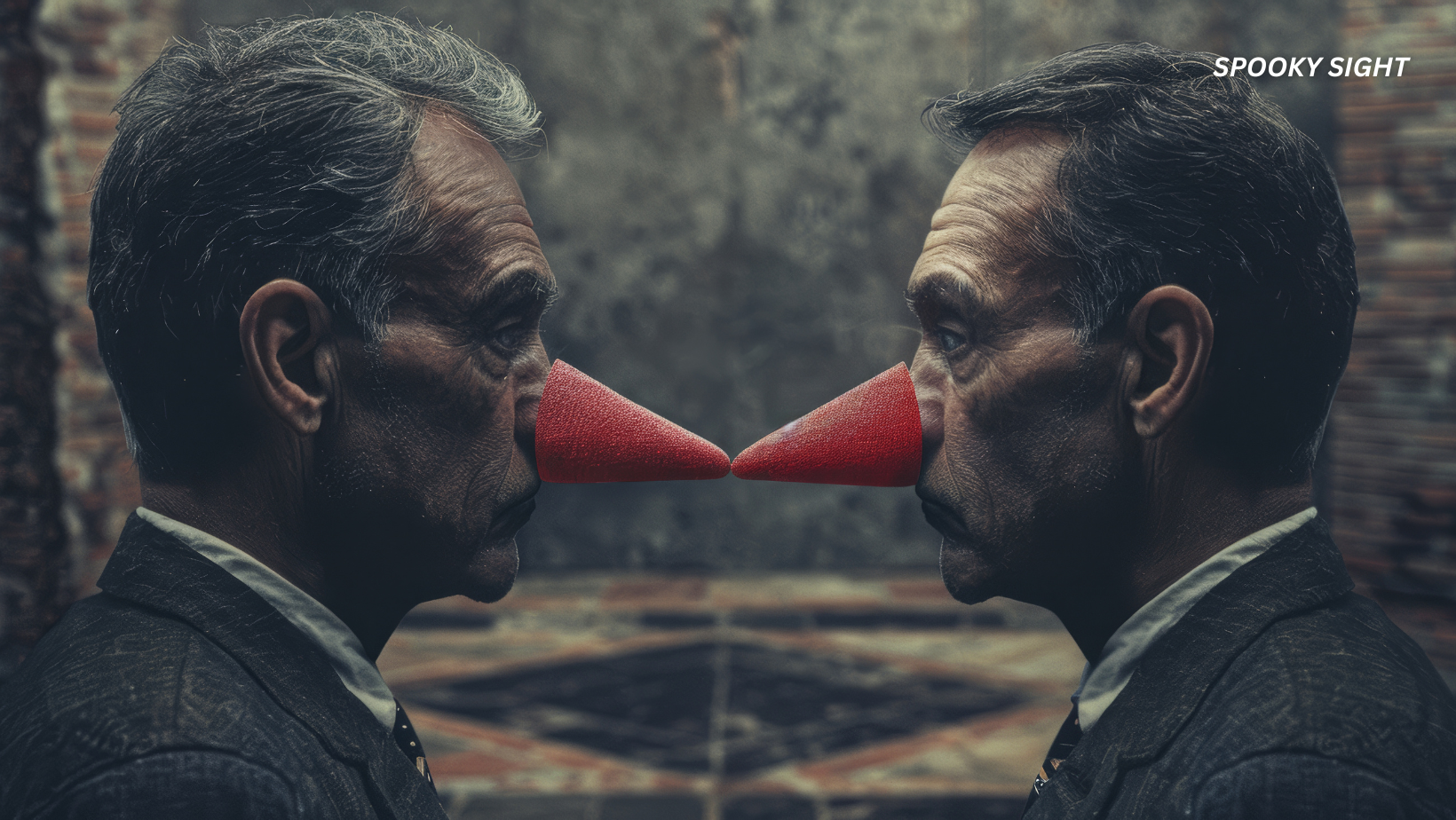Gilles Garnier, also known as the Werewolf of Dole or the Hermit of St. Bonnot, was a French serial killer and hermit convicted of lycanthropy (werewolf transformation) in 1573.
He lived near Dole, France, in isolation with his wife. Garnier was described as a somber and reclusive individual with a pale face and deep-set eyes.
His crimes—and subsequent trial—offer a glimpse into the social and legal practices of 16th-century Europe, where superstition and fear often overshadowed reason.
In this article:
Gilles Garnier: The Werewolf of Dole
The bizarre case of Gilles Garnier is a fascinating and chilling narrative that intertwines mythology and reality.
Known notoriously as the Werewolf of Dole (and sometimes as the Hermit of St. Bonnot), Garnier’s life as a hermit on the fringes of society in 16th-century France sets a grim backdrop for his infamous transformation.
Even today, many centuries after the events, he’s still typically associated with a figure who embodied the darkest tales of lycanthropy and human depravity.
So what exactly happened?
Well, according to historical records (which, bear in mind, often reflect the strange and distorted beliefs of the time), Garnier was a recluse who lived just outside the small town of Dole, in eastern France, near the current Swiss border.
He led a simple lifestyle, but in many ways, that simplicity might have set the stage for the horrific legend he would become. But unlike the werewolves of ancient mythology and fantastical stories, Garnier’s actions weren’t just the stuff of folklore.
His crimes were chillingly real—and included the brutal murders and cannibalization of several children. His acts terrorized the local community and blurred the lines between man and mythic beast.

Historical Background
The 16th century was a time of intense superstition and widespread belief in the supernatural across Europe.
Witch hunts were common. Most people believed in the existence of werewolves and other mythical creatures.
And let’s not forget that Garnier lived as a hermit in the forests around Dole. The period was marked by economic hardship for many, with poverty and famine not uncommon.
Living in isolation and struggling to survive could have driven Garnier to extreme measures to obtain food, contributing to his horrific crimes. His solitary lifestyle also made him an easy target for accusations of witchcraft and werewolf-like behavior.

Lycanthropy in Europe
The origins of European werewolf legends stretch back to Antiquity, with the first records dating from ancient Greek and Roman times.
We can find one of the earliest references to werewolves in the work of the Greek historian Herodotus (circa 484–425 BCE). In “The Histories,” Book 4, chapter 105, he wrote about the Neuri, a tribe from Scythia (near modern-day Ukraine and Russia):
“It may be that these people are wizards; for the Scythians, and the Greeks settled in Scythia, say that once a year every one of the Neuri becomes a wolf.“
However, 13th to 18th-century Europe was completely different. Far from being mere folklore, the belief in werewolves was interlaced with the era’s understanding of witchcraft, demonic possession, and the supernatural.
In this period, lycanthropy was not just a tale to be told in hushed tones by the fireside.
For many, it was a genuine affliction (or curse) that could befall the unwary or the wicked—as Aleksander Pluskowski also points out in “Before the Werewolf Trials: Contextualising Shape-Changers and Animal Identities in Medieval North-Western Europe.”
And, as you might expect, the stories of humans turning into bloodthirsty monsters were quite common.
Here are just some examples:
Peter Stumpp (Germany, late 16th century)
Peter Stumpp (Peter Stubbe), a simple German farmer from the Electorate of Cologne, was accused of being a werewolf, practicing black magic, and committing several crimes (including cannibalism).
His trial and execution in 1589 became legendary for its brutality and the gruesome details of his supposed crimes.
Jacques Roulet (France, 1598)
Jacques Roulet was discovered covered in blood and charged with lycanthropy in Angers, France.
His case is noteworthy for the court’s ruling to consider him mentally ill rather than a werewolf. This decision led to his sentence to a mental institution instead of the death penalty.

Wolf of Ansbach (Germany, 1685)
The Wolf of Ansbach is actually a case where a wolf (but believed to be, in fact, a werewolf) terrorized the town of Ansbach. When it was killed, its body was dressed as a man and displayed publicly.
Hans the Werewolf (Estonia, 1651)
Hans the Werewolf was tried and executed for being a werewolf at a young age, demonstrating the reach of werewolf trials into Eastern Europe and the Baltic regions, where local folklore and beliefs influenced legal proceedings.
Beast of Gévaudan (France, 1764-1767)
The Beast of Gévaudan terrorized the province of Gévaudan in south-central France and was responsible for numerous deaths.
While not a human werewolf case, the beast was often thought to be a werewolf or werewolf-like creature.
You may also enjoy:
- Who Is Abaddon in the Bible? The Destroyer and the Apocalypse
- The Real Annabelle Doll: Haunted Object or Demonic Conduit?
- Busby’s Stoop Chair Curse: Did It Really Killed Over 60 People?
The Werewolf of Châlons (France, late 16th century)
Also known as the Demon Tailor, an unidentified man was executed in Paris for allegedly luring children to his shop, murdering them, and attempting to eat them.
His case was too tied to lycanthropy through the savage nature of his crimes and the widespread belief in werewolves at the time.
Thiess of Kaltenbrun (Germany, 1692)
In a somewhat different perception of lycanthropy, a man known as Thiess of Kaltenbrun allegedly confessed to being a werewolf.
However, he also claimed that he (and other werewolves like him) were, in fact, warriors of God, fighting against witches and the Devil in Hell to ensure good harvests.
The Crimes of Gilles Garnier
But let’s get back to our case at hand. With a bit of research, you, too, can find various sources discussing the legend of Gilles Garnier, the French hermit accused of being a werewolf.
We found Jean Bodin’s 1580 book “De la Démonomanie des Sorciers” (On the Demon-Mania of Witches) to be an excellent source. Bodin dedicates a chapter to the case of Gilles Garnier, providing details of his crimes and conviction.
The 2009 “Man as Witch: Male Witches in Central Europe” by Rolf Schulte is another good read. Schulte briefly discusses Gilles Garnier as an example of a male witch accused of cannibalism during the 16th-century witch trials in France.
Finally, we also recommend Sabine Baring-Gould’s “The Book of Werewolves,” which provides more historical context and narratives related to this fascinating legend.
Shall we begin with our story? Here’s what happened (based on the available information and historical records):
Multiple Murders and Cannibalism
Gilles Garnier committed a series of brutal attacks near Dole, France, particularly in the St. Bonnot Woods.
His heinous acts included the murder and cannibalism of children, with at least four victims between the ages of 9 and 12.
Garnier’s first known attack was on a 10-year-old girl in a vineyard outside Dole in October 1572. He strangled her, ate the flesh from her thighs and arms, and took some flesh home to his wife.
Subsequent attacks followed a similarly gruesome pattern. Garnier allegedly attacked, killed, and ate parts of his young victims, sometimes taking parts of their bodies home.
Local French authorities documented his bestial savagery during the trial, highlighting the locations and nature of these attacks.

Apprehension and Accusation
Garnier’s crimes weren’t isolated incidents. In fact, the whole region had been plagued by a series of mysterious events: missing children (with some found brutally murdered), plagued crops, and dead livestock.
Many of these events were likely unrelated. But some disappearances and murders were probably linked.
Nevertheless, all fueled the panic that had gripped the populace, driven by whispers of a monstrous loup-garou (werewolf) preying on the innocent.
That’s probably why—in a desperate attempt to restore some order—local authorities had issued an edict permitting the capture of this mythical beast.
So, as far as we know, Gilles Garnier’s capture wasn’t a stroke of luck. It was the culmination of mounting fear and the many gruesome discoveries that preceded it.
According to kept documents and journals, a group of workers traveling near Dole in 1573 witnessed a horrifying sight: a mysterious figure (later identified as Garnier) hunched over the body of a dead child.
To no surprise, as soon as the workers found Garnier next to the body of a child, he immediately became a prime suspect. And not of that crime alone—but for all the deaths that had plagued the region.
The existing fear and the official decree undoubtedly played a crucial role in his swift apprehension.
However, it’s important to note that historical accounts like “Arrest memorable de la Cour de Parlement de Dole, donné à l’encontre de Gilles Garnier” (published in 1574) focus heavily on the lycanthropy angle and mention nothing about any sort of investigation into the actual crimes.
On the other hand, modern analysis suggests a more likely scenario: a disturbed individual responsible for the child murders, with the “werewolf” narrative serving as a convenient explanation for the brutality amidst a superstitious populace.
Confession and Trial
At his trial, Garnier confessed to the horrifying acts, claiming that a specter had appeared to him while he was hunting in the forest.
This specter allegedly offered Garnier an ointment that would transform him into a wolf, making it easier for him and his wife to hunt for food (The Green Bag (1889–1914), Volume 15, The Trial of Gilles Garnier).
While some skepticism surrounds such hard-to-believe claims, it’s important to note the context we talked about already.
Belief in werewolves and demonic pacts was prevalent during this period. Whether Garnier genuinely believed his story or used it as a defense tactic remains unclear.
Garnier admitted to stalking, murdering, and cannibalizing the children, detailing how he had attacked his victims and describing the attacks.
More than 50 witnesses testified against him. What exactly did they say? We don’t know. However, the local authorities had no issues amasing a tremendous amount of evidence for his crimes.
We have no doubts that many of these “witnesses” made up their stories. But that didn’t stop the authorities from considering their testimonies.
The witnesses’ accounts detailed Garnier’s predatory behavior, including stalking victims and displaying an unsettling knowledge of local hunting grounds.
However, despite the sensational nature of the case, Garnier was tried by secular authorities rather than the Inquisition. How so? Well, the Inquisition primarily focused on heresy, and while some might argue lycanthropy falls under that umbrella, it wasn’t their primary concern.
Instead, Garnier faced trial for the very real crimes of murder and cannibalism.
According to Reginald Scot, in “The Discoverie of Witchcraft“ (1584):
“[…] it is not the witch that doth the deed, but the devil that doth it by the witch, and the witch is but a mere instrument or tool of the devil.”
Some evidence suggests Garnier underwent trial by ordeal, a common practice where the accused endured physical tests believed to reveal guilt or innocence.
The specifics of these ordeals for lycanthropy are unclear. However, they likely involved searching for physical signs of transformation, such as unusual markings or excessive body hair.

Verdict and Punishment
Gilles Garnier’s fate was sealed on January 18, 1574, when he was found guilty of “crimes of lycanthropy and witchcraft” by the secular authorities.
The court sentenced Garnier to death by burning at the stake.
As it was common for witchcraft and lycanthropy cases at the time, the death sentence was first reviewed and approved by the higher court in Dole before being carried out.
Garnier’s sentence and execution were documented in detail in historical records (including in the 1574 “Arrest Memorable de la Cour de Parlement de Dole”):
“Wherefore this Most High and Honourable Court, having carefully considered the plea of the Prosecutor and having made full inquisition into all depositions and interrogatories touching this present case as well as duly weighing the full and free confessions of the accused, not affirmed and deposed once only but many times unambiguously reiterated, acknowledged and avowed, doth now proceed to deliver sentence, requiring the person of the accused to be handed over to the Master Executioner of High Justice, and directing that he, the said Gilles Garnier, shall be drawn upon a hurdle from this very place unto the customary place of execution, and that there by the aforesaid Master Executioner he shall be burned quick and his body reduced to ashes.”
Conclusion
The case of Gilles Garnier stands as a chilling testament to the power of superstition and fear in shaping historical narratives.
While the existence of werewolves remains firmly in the realm of myth, Garnier’s story echoes other European cases from the 16th and 17th centuries:
- Peter Stumpp of Bedburg (Germany, 1589)
- Michel Verdun of Provence (France, 1584)
- Deacon Jean Grenier (France, 1603)
Though separated by geography, these events share a common thread – a desperate search for explanations amidst societal anxieties and a lack of scientific understanding.
Frequently Asked Questions
Was Gilles Garnier a real werewolf?
No concrete evidence suggests that Garnier was a real werewolf. He was accused and convicted of being a werewolf due to the brutal attacks on children and livestock in the area.
What evidence was used to convict Gilles Garnier?
The evidence used to convict Gilles Garnier was based on the gruesome nature of the attacks and the belief in werewolves at the time.
How many people did Gilles Garnier kill?
Gilles Garnier was accused of killing several children and livestock in the area. The exact number of victims is not known, but it is clear that his crimes were brutal and horrific.
What was Gilles Garnier’s punishment?
Gilles Garnier was sentenced to death for his crimes. He was burned at the stake, a common punishment for heresy and witchcraft during that era.
Was Gilles Garnier mentally ill?
While mental illness might be a factor in some historical cases, there’s no evidence for it in Garnier’s case. His case was based on the belief in werewolves and the gruesome nature of the attacks, not on any mental health issues.
What is the historical context surrounding Gilles Garnier’s case?
Gilles Garnier’s case occurred in the 16th century when superstition and fear of the unknown were prevalent. The belief in werewolves was widespread, and individuals accused of such crimes were often subject to harsh punishments, including death.
How did the belief in werewolves influence the case?
The belief in werewolves played a significant role in Gilles Garnier’s case. The attacks on children and livestock were attributed to a werewolf, leading to his capture and subsequent trial. The superstition and fear surrounding werewolves contributed to the tragic outcome of his case.
Are there any other historical werewolf cases?
Yes, there are other historical werewolf cases. The belief in werewolves was widespread during the Middle Ages and the Renaissance, and individuals accused of such crimes were often subject to harsh punishments. Some other notable cases include the Werewolf of Bedburg and the Werewolf of Dudley.
What is the difference between lycanthropy and psychosis?
Lycanthropy is the belief in the existence of werewolves. At the same time, psychosis is a mental disorder characterized by a loss of contact with reality. Gilles Garnier’s case is an example of lycanthropy, as he was accused of being a werewolf based on the belief in such creatures, not on any mental health issues.







